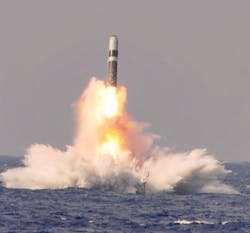Lockheed Martin to build submarine-launched nuclear ballistic missiles with inertial and celestial guidance
WASHINGTON – Strategic weapons experts at Lockheed Martin Corp. will build additional UGM-133A Trident II D5 submarine-launched nuclear ballistic missiles and support deployed D5 nuclear weapons under terms of a $2.1 billion order announced in late September.
Officials of the U.S. Navy Strategic Systems Programs (SSP) office in Washington are asking the Lockheed Martin Space Systems segment in Titusville, Fla., to provide for Trident II (D5) missile production, deployed systems support, and warhead 93/Mark 7 development for the U.S. Navy and United Kingdom Royal Navy.
The warhead 93 is an American nuclear warhead planned to replace the W76 and W88 warheads on U.S. Navy submarines from 2034. The warhead will be carried on the future Columbia-class ballistic missile submarines and will use a new aeroshell and the Mark 7 reentry body.
The warhead will be designed by Los Alamos National Laboratory in Los Alamos, N.M. The Mark 7 reentry body also will house the United Kingdom's new warhead, designed in parallel to the warhead 93 and sharing some non-nuclear components. The warhead is expected to have safety features like insensitive high explosives.
The Trident II D5 is one of the most advanced long-range submarine-launched nuclear missiles in the world. It is the primary U.S. sea-based nuclear ballistic missile, and is deployed aboard U.S. Navy Ohio-class ballistic missile submarines.
Navy operates 14 ballistic missile boats
The U.S. Navy operates 14 of these ballistic missile submarines, each of which can carry as many as 24 Trident II missiles. Although the Trident II is designed to carry as many as 12 multiple independently targetable reentry vehicle (MIRV) warheads, current treaties reduce this number to four or five.
Each Trident II missile has a range of 4,000 to 7,000 miles, and its navigation subsystem uses a combination of inertial and celestial guidance. The Trident II D5 was first deployed in 1990 and is scheduled to remain in service until at least 2027.
The Navy started the D5 Life Extension Program in 2002 to replace obsolete components using as many commercial off-the-shelf (COTS) parts as possible to keep costs down and to enhance the nuclear missile's capability. Draper Lab is in charge of upgrading the Trident II's guidance system, and has been working on this project since 2005.
In practice, the Trident II missile's inertial measurement system receives targeting data from computers aboard the submarine. The inertial measurement unit then transmits signals to the D5 flight-control computer and converts them into steering commands to keep the ballistic missile on target.
Command and control
The missile's post-boost control system maneuvers the missile in flight to observe stars for the missile's celestial navigation subsystem, which updates the inertial system in flight.
Lockheed Martin also is integrating the Trident II onto the next-generation ballistic submarine designs of the U.S. and United Kingdom by adapting the Trident II missile and reentry subsystems into the common missile compartment for the future Columbia-class missile submarine and United Kingdom Dreadnought class missile boats.
The Columbia-class ballistic missile submarine is being designed to replace the Navy's fleet of Ohio-class submarines. The future United Kingdom Dreadnought submarine, meanwhile, will replace the Royal Navy's fleet of Vanguard-class ballistic missile submarines.
The U.S. Navy today operates 18 Ohio-class submarines -- 14 of which carry the Trident nuclear missile. Four Ohio-class subs have been modified to carry conventionally armed long-range cruise missiles.
The Ohio-class submarine has been in commission since 1981, and this class is scheduled to be decommissioned and replaced starting in 2029. The United Kingdom Vanguard-class ballistic missile submarine has been at sea since 1993. The Royal Navy operates four Vanguard-class subs.
On this order Lockheed Martin will do the work in Denver; Valley Forge, Pa.; Titusville, Fla.; Magna, Utah; Kings Bay, Ga.; Bangor, Wash.; Sunnyvale, Calif.; Kernersville, N.C.; Camden, Ark.; Biddeford, Maine; and other locations, and should be finished by September 2029.
For more information contact Lockheed Martin Space Systems online at https://www.lockheedmartin.com/en-us/products/trident-ii-d5-fleet-ballistic-missile.html, or the Navy Strategic Systems Programs office at www.ssp.navy.mil.
About the Author
John Keller
Editor-in-Chief
John Keller is the Editor-in-Chief, Military & Aerospace Electronics Magazine--provides extensive coverage and analysis of enabling electronics and optoelectronic technologies in military, space and commercial aviation applications. John has been a member of the Military & Aerospace Electronics staff since 1989 and chief editor since 1995.
